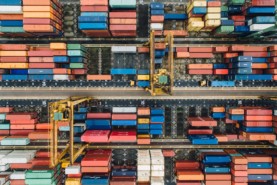Posted on 24 Oct 2018
Trade infrastructure may enable the economic benefits of globalization, but at the same time it can also make countries more vulnerable to organized crime.
Not all countries are equally susceptible to organized crime, and there are many factors that influence their degree of vulnerability. For example, high levels of unemployment may leave a greater number of people at risk of recruitment by street gangs and organized-crime syndicates that exploit the desire for social inclusion and economic livelihood.
Governments that prioritize the reduction of unemployment rates – in particular, youth unemployment – may find that they are able to kill two birds with one stone: achieving core development objectives while reducing vulnerability to organized crime.
The UN’s inclusion of an objective focused specifically on organized crime in its Sustainable Development Goals (SDGs), namely SDG 16.4, is indicative of the recognized close relationship between organized crime and the wider development agenda. Development policies and attempts to counter organized crime are, quite rightly, seen as working towards the same goals.
However, it cannot be universally assumed that improving development indicators results in a reduction in organized crime. In fact, in some core development sectors economic growth may prove a double-edged sword.
The licit–illicit economy paradox
Economic development and the enhancement of infrastructure to maximize global trade integration, as per SDG 9, is a major development priority for many regions. The African Union’s Agenda 2063 outlines plans to work towards something similar to a single African market, which would involve the free movement of goods, services and capital, with the aim of facilitating intra-African trade. It is well recognized that trade has a positive effect on a country’s overall income, which is, in turn, a key driver of poverty reduction and improved quality of life in developing nations.
In order to maximize trade, a state must invest in trade infrastructure in the form of roads, railways, airports and seaports. An assessment published in 2015 showed that, overall, global investment in trade infrastructure can be expected to increase at an annual rate of approximately 5% until 2025. For sub-Saharan Africa, this increases to 11% – the highest growth rate for any region in the world.
At the same time, however, organized crime also needs roads, seaports and airports in order to thrive. If the infrastructure in a country is substandard, criminals are constrained in their ability to travel, communicate and transport goods. Major nodes in the global trade network, such as ports and airports, are therefore vulnerable to becoming hubs of the illicit economy too.
In the drug-trafficking market, for example, 65% of all confiscated drugs are seized in ports and at sea. As the numbers of airports and seaports proliferate, it becomes increasingly difficult to monitor them for illicit activity. But countries such as Nigeria have recognized this source of vulnerability and taken measures to reduce the circulation of counterfeit medicine by banning the import of medicine in all but two national points of entry.
Even the most modern ports are capable of inspecting only a tiny minority of shipments. Of the 500 million maritime containers shipped yearly in the global trade supply chain, less than 2% are inspected. If a country already has large volumes of goods to trade, criminal organizations are able to infiltrate the licit trade routes more easily and with less risk of detection. Additionally, the more points of entry a country has, the more opportunities there are for organized-criminal groups (OCGs) to evade already stretched law enforcement.
With limited resources, enforcement agencies at trade hubs must decide which areas to prioritize. David Danelo, a senior fellow at the Global Initiative, argues that this is very much akin to the medical process of triage. By this, he means that the detection of explosive, nuclear and radiological materials takes priority, while preventing illicit goods from entering the global supply chain is unfortunately (though rightly) forced to take a back seat.
Port vulnerability to cybercrime
Illicit trade is not the only form of organized crime that seeks to exploit trade infrastructure. Trade in the 21st century is heavily dependent on cyber networks for everything from placing an order and tracking the transportation, to the loading and unloading of goods, and the logging of security information. These computer and communication networks allow goods to flow freely across the globe and are crucial for global trade.
The vital role of cyber networks in the maritime transport sector is a key factor in their vulnerability to organized crime. OCGs can attack port cyber networks in a number of ways. These include accessing sensitive information, gaining access to commandeer a ship or even closing down a port entirely. Any attempt to disrupt the flow of goods in ports would be hugely damaging to the economy as a whole – even a relatively small cyberattack can cause millions of dollars’ worth of business losses.
Perhaps surprisingly, then, investment in port cybersecurity has been severely lacking. The importance of the role played by cybersecurity in the maritime transport sector was largely ignored until 2017, when the ‘NotPetya’ malware attack struck. In the US, no common standards have been disseminated; hardly any port authorities have carried out cyber risk assessments; and of the US$2.6 billion allocated to the Port Security Grant Program, less than 1% was awarded for cybersecurity projects.
A simplistic view of the crime–development nexus
The exploitation of trade infrastructure by OCGs is a problem without a straightforward solution. In an increasingly globalized world, the sheer volume of trade taking place has facilitated the growth of illicit cross-border trade. But the solution is not simply to introduce barriers to trade in the hope of stemming the growth of the illicit economy. As Ivan Briscoe of the International Crisis Group argues, ‘tougher policing of the interstices of commerce runs the risk of slowing up trade flows and harming business links’. This would, in turn, hamper a country’s prospects for development, and perhaps also force a reliance on illicit ways of getting products to the market.
What is required more than anything is therefore a recognition by the international community that the relationship between development and organized crime isn’t as straightforward as many may like to believe. In many respects, the idea of a negatively correlated and mutually reinforcing development–crime cycle is unquestionably simplistic. Investment in a country’s trade infrastructure can lead to increased scope for exploitation by OCGs, and in the absence of an adequately nuanced government response, it often does.



